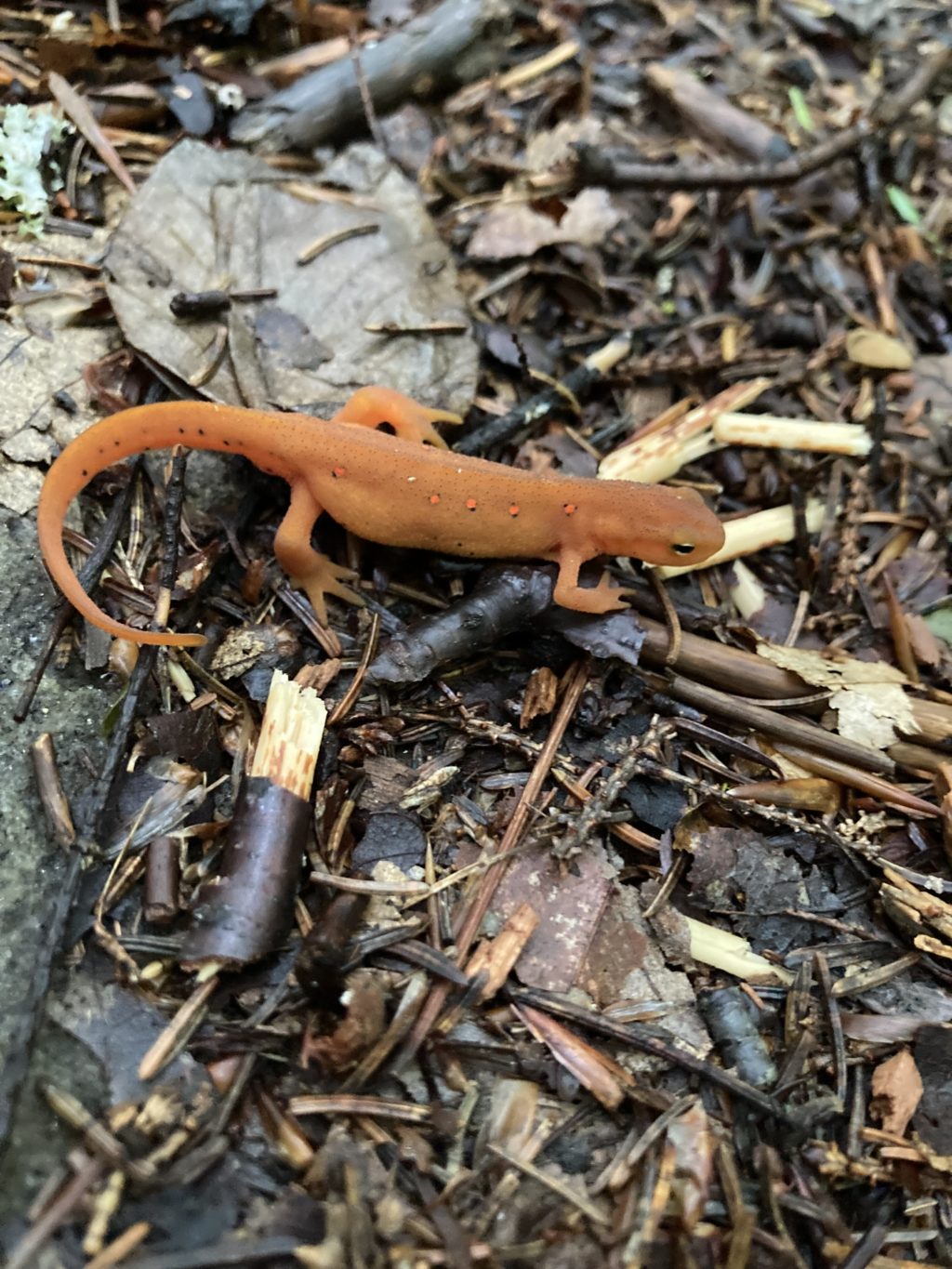Almanac: Eye Of Newt

Eastern Red-Spotted Newt (Notophthalmus viridescens). Photo: Stephen Braun
I went mushroom hunting with some friends last weekend under grey, drizzly skies in some wooded hills near Haydenville. We found lots of edible ‘shrooms including king boletes, two kinds of chanterelles, black trumpets, oyster mushrooms, and slippery Jacks. (And by “we” I mostly mean my sharp-eyed and much more knowledgeable companions—I’m still a mushroom forager-in-training.)
As we bushwhacked through the woods, eyes scanning for fungi, I kept being distracted by red-spotted newts. These small, bright-orange salamanders seemed to be everywhere, hanging out on moss, logs, or on the leaf-strewn forest floor. They’re quite docile little creatures and submit readily to being picked up for a closer look.
Newts are a subgroup of salamanders distinguished by their three-phase lifecycle. They emerge in spring from eggs laid underwater and grow into swimming larvae with feathery external gills. After several months the larval newts are transformed in a hormone-induced metamorphosis. The gills disappear and lungs develop. Their two-chambered heart becomes three-chambered to better handle the oxygen from the new lungs. Their skin thickens and their tails become rounded.
Once the changes are complete, they walk onto the land, at which point they are called “efts.” When the efts become sexually mature after one-to-three years they undergo another metamorphosis and revert back to aquatic creatures. They lose their bright color, develop a more blade-like tail, and their skin becomes thinner and more slimy. In this adult stage they mate, the females lay eggs, and both sexes can live for more than a decade.
The red spots along both sides of the eft’s body, in addition to the bright orange skin itself, are neon signs saying “You’ll be sorry if you eat me.” Eft skin, particularly that on the exposed back, contains a poison called tetrodotoxin (the same neurotoxin found in puffer fish). Animals such as mice and toads that were force-fed dead efts display a range of behaviors such as regurgitation, gaping, salivation, or pawing at their tongues that demonstrate just how unpalatable these newts are. (Here’s a curious little factoid: the “eye of newt” of Macbeth fame has nothing to do with actual newts or their poisonous skin. All those seemingly-macabre ingredients the witches throw into their cauldron are actually plants. In this case “eye” refers to a blossom or seed and “newt” was another name for the mustard plant. So “eye of newt” really just meant “mustard seed.” But if Shakespeare had used the plant names it would have sounded like the witches were making a nice soup rather than calling forth ghosts.)
Research with another species of newt by researchers at the Brodie Lab of the University of Virginia has shown there’s an “arms race” going on between the levels of tetrodotoxin in the newts, on the one hand, and resistance to that toxin in garter snakes, on the other hand. I’m curious to know how toxic a creature can be to predators before the toxic compound itself causes problems for the creature’s metabolism or physiology.
The efts we saw last weekend were out and about because it was a humid, wet day, which allowed them to hunt for small insects without drying out. Other species of salamanders, such as our locally famous yellow-spotted salamanders, do not have the eft’s thicker skins and, therefore, usually forage and hunt invisibly underneath the leaf litter of a forest floor or in rotten logs.
A final cool thing about these cute little critters: red spotted newts, like many amphibians, have an astounding capacity to re-grow lost limbs or tails. Exactly how this occurs, at a genetic and molecular level, is still not fully understood, although it’s a topic of intense research. Unlocking the mysteries of limb regeneration in newts and other creatures could open the possibility of stimulating the same kind of regeneration in humans who have lost limbs in accidents or warfare. That would amount to a kind of secular magic far more powerful and useful than anything a coven of witches could brew up!
Almanac is a regular Indy column of observations, musings, and occasional harangues related to the woods, waters, mountains, and skies of the Pioneer Valley. Please feel free to comment on posts and add your own experiences or observations.

I too spotted an early-morning Eastern-red-spotted newt eft on the rain-wetted farmhouse porch slate in Birchrunville, PA over the Labor Day weekend!
Hurricane season must be “back-to-school-time” for these amphibians up and down the East coast!